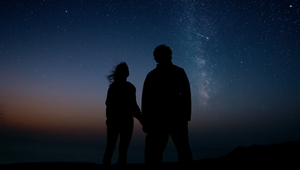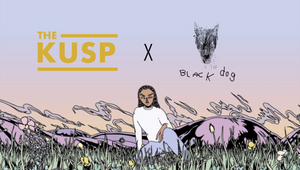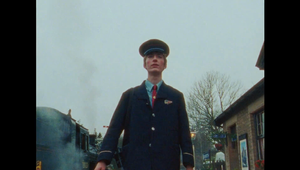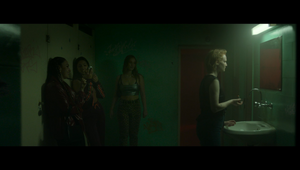
Into the Library with Jake Scott

'The Creative Library' is LBB’s exciting new launch. It’s been months - years, probably - in the making and we reckon our re-tooled archive will change the way you work, whether you’re a company looking to store and share your work, or a marketer or creative looking for new partners or inspiration for your latest project.
This isn’t a dusty old archive. It’s an easy-to-search, paywall-free library where all our members can store and share all of their reels and creative work.
To coincide, we’re also launching a new regular feature called ‘Into the Library’ where we catch up with the industry’s most influential directors to talk about their directorial highlights past and present. Think of it as a director’s reel showcase with a big dollop of personality. We interview directors about their favourite commercials and music videos from their reel to find out about how these works shaped them as a director.
Today, we’re excited to continue the journey into the creative worlds of the best directors out there, with Jake Scott.
—
I'm sure every director feels this way. When you’ve got a certain body of work and you've done a lot of different things. I was looking back at the work and trying to think about the ones that actually did change things in terms of progression, the ones that made a difference, opened doors or were significant in my development. You look at them differently. There's tons of work I would like to have included but these were the ones that did that.
REM - Everybody Hurts
'Everybody Hurts' put me on the map a bit. It stood out at the time. I think because nobody until that point had done anything that was realist. Everything was quite stylized or conceptual. There was a vernacular and a language for music videos. I was in my mid 20s and I knew I was sticking my neck out. But I was frustrated with where I was sitting. I had made a couple of music videos at that point, but I wanted to make a good video.
I'd done a video for k. d. lang with Warner Bros. - black and white, shot in Prague. Randy Skinner, this commissioner at Warner Brothers thought it was really good and put me up for the REM video. I know that Tarsem [Singh] was already recce-ing for ‘Everybody Hurts’. He'd done 'Losing My Religion', which of course was a brilliant video. I don't know why they made the decision to go with me but I got lucky.
'Everybody Hurts' is quite an epic song that builds and builds to a crescendo. And it's a country song, really. I loved REM, anyway. I was sitting in a traffic jam in LA, listening to the track, and it clicked. The pace of the traffic jam was the pace of the track: Roll, stop. Roll, stop. And then I remembered the beginning of '8½', my favourite Fellini film, began with a dream sequence in a traffic jam. It just built from there. Over the course of that weekend I drove out to Joshua Tree alone and wrote this very detailed treatment about people in their cars who are all in some way experiencing pain or anguish – hurt.
I was idealistic. I thought I was paying homage to these great directors like Fellini and Wim Wenders. In 'Wings of Desire' the angels were walking around and could hear the thoughts of the mortals. So it was a combination of 'Wings of Desire' and '8½' told through the band and the song. I would never have admitted that until now, but that's what it was.
I was terrified that I was going to blow it. We ended up in San Antonio, Texas, because it was the only part of the freeway that we could shut down for a few days. We had a pretty big budget. Music video budgets at that time were significantly higher. I was full of myself, but I was terrified inside.
I spent weeks and weeks, maybe even months, editing it, because we had a lot of footage. And we were given the time because they held the album back for release. So I fiddled with this for a year. The subtitles, the thoughts of the characters, changed. We rewrote them and rewrote and rewrote and tried new things. And it was just a perfect storm of time, money, a band who were intelligent and wanted to push things, and the support of the record company.
It did change everything. I'd been knocking about in commercials a little bit at that point. Music video was really where I wanted to be. And it opened all the doors I wanted it to. I won an MTV award. Then suddenly you're getting phone calls from talent agencies and everybody wants you and it all goes to your head.
Nike - Move
Nike was the gold standard in American advertising. I'm from London, but I'd moved to California to work as an art director. It was the late '80s or early '90s and I got seduced by it in a way. A lot of people came over from London. And we had a little bit of a club scene going, so we translated it over. While the Summer of Love and all the rave culture was really kicking off here, there was a parallel thing happening over there.
So I'd started my career as a director in the States. I had been doing commercials for some time. I had some repeat business and regular accounts. I was chugging along, but enjoying music videos much more.
Now, all the good creative is going to the exciting new talent coming out of music videos. We see it ourselves at Black Dog. Whereas back then there was a real snobbery about music videos. In the '90s and I think well into the '00s [advertising] was closed to music video directors. So at the time I was doing lots of music videos.
I'd gone off and made a feature film called 'Plunkett & Macleane' that was not well received critically. By no means was it a perfect film, but it had a lot of ideas. I was immature as a director in terms of making a feature film, so it was probably a bit big for me at the time. But I was Billy Big Bollocks as well. I tried some things in that film that I think have now become part of an accepted language in terms of the anachronistically told period stories, the use of modern music in period context and a lot of I guess what they call postmodernism rather pretentiously. But at the time it got destroyed by all the film critics. And I went into a hole. And went back to commercials and thought "Fuck, I'd better apply myself here and try and at least focus on that".
Nike 'Move' came shortly after I finished ‘Plunkett & Macleane’. Wieden + Kennedy would test you out on a few little ones. And then if you did it well they'd try you on a bigger one and then a bigger one. I read the Nike 'Move' script and thought “this is the one”. It was Mike Byrne who would go on to start Anomaly - a bit of a legend. Mike and I had already developed a relationship. I remember it was a fairly tough fight to get it.
I really stuck to my guns on one thing. I said if you're going to do a study of movement, it has to be real-time movement. I was being a bit of a film student about this because I said look at the motion studies of Eadweard Muybridge. While it's always captivating to shoot everything in slow motion, that's not truth. That athleticism in real time, if you can capture it, really gives you all the spontaneity, the energy, the dynamism. To me it was a motion study of humans in athletic pursuit.
We had a lot of time. It was a big shoot, I think maybe even 16 days. We really had time to work out the camera movement, the placement, also the rhythm of it, because it was a very musical thing. I'm very, very, proud of that piece of work because I think it stood the test of time. I think in some ways it really influenced this whole thing about transitions.
We kept going "do you think we should shoot this bit in slow motion?" But all of us stick to our guns. There were no tricks. It was just about getting those cuts right, the angle, the distance and the focal length. I think we even shot it on one lens.
HBO - Voyeur
I believe this was my first foray into what you would call long-form branded content. So it wasn't an ad but it was an ad. It wasn't for television; it was almost an art installation. The assignment was to present HBO as the place where you can see comedy, drama, thrillers.
The concept was that we would see into an apartment building in New York City. It was cutaway. Like a doll's house. We based it on what would have been an old tenement in the East Village. Ludlow and Broome was the corner.
It was a real geometry thing. We worked out what the angle from the ground would be looking into those apartments, how much of the ceiling you would be seeing. There were four floors in the script. We built two floors of this building – one on each stage in Hollywood – exactly to the dimensions. We decided that each floor plan would be the same, as you'd often find in apartment buildings, and there'd be a central stairwell. And so on a four-day shoot so we had a day per floor. We'd shoot the first floor, redress, go and shoot the second floor. It was very organised.
It was the first time I'd worked with a continuous take. I think it was six or seven minutes. It had to have coordinated, interacting action between floors that didn't actually connect in reality. All your timings had to be spot on. It was like conducting. It was a completely different way of directing. I worked with a drama group that I had been workshopping with, rehearsed and rehearsed for a week, marked it all out. It was brilliant fun. I learnt a lot. Terrifying of course.
It was unusual because the premiere for it was projected on the side of that building, on Ludlow and Broome in the East Village on a summer's night. And it played for eight nights. We had speakers on top of the rooftops, positioned at that intersection. It was a moving billboard.
It won a lot of awards and it was really well noticed. It was seen as a significant moment in advertising I guess. It was a brilliant, fun thing to do.
George Michael - Flawless
There's no effects, it's all one shot, no post, nothing. It was just good-fashioned blocking and choreography. I picked that one because it wasn't a huge hit. I think it was more of a hit in Europe than anywhere else. It didn't play in the States at all because George was ostracised and they were so moralistic about things at that time.
For me why it was significant and I love it is that I've always loved dance and wanted to do some choreography that was not what I would call traditional. It evolves and develops into a moment where there is a coordinated routine. But I think it's four bars or something. The rest of it devolves and people go back to what they're doing. But I'm in love with Bob Fosse, I love dance, and I'd never tried it before and I didn't know if I had the knack for it. Admittedly I had Michael Rooney, a very good choreographer to work with. But we blocked it together.
For me, the single shot thing coordinated in such a way that you weren't even necessarily aware that it's a single shot.
For when it was made, if you look at it carefully, the casting is very diverse. I had a trans character, all shapes and sizes, it was very carefully considered in terms of casting and diversity. George was really good at this in his videos, but at that time it was still very segregated in US music videos. There was very little diversity. I'm proud of it because it was exactly the video I had intended it to be.
It got a Grammy nomination, but it wasn't noticed at the time – nobody really gave a fuck about it. I realised I actually could do something that's choreographed with dance. So I'm immensely proud of it and I love the music video. I don't know why I've never done anything like that again, but I should. I really just love it.
Johnnie Walker - The Gentleman's Wager
Branded content was well up and running at this point. Apart from really enjoying the experience, this had a kind of old-fashioned quality about the story. It's these two old friends – a younger man and an older man – getting together for a drink. They have their wager. I think there's a '60s Michael Caine film sort of thing about it. Even 'Dirty Rotten Scoundrels' in some ways.
It was a piece of what they call branded content. But I really thought of it as a short film and a short story and they really allowed it to play that way. Johnnie Walker has a nice iconography about it. It's whisky, it's to be enjoyed between people and friends and so there are a lot of components that add up to tell that story in a nice way.
I get a lot of compliments about it, still. I slightly question now that Jude gets 12 women to come and dance with him for Giancarlo. I think we handled it correctly. Is it the male gaze? I don't know. It wasn't sexualized. I didn't want it to go there. It's about the music and the dance. The other thing is it wasn't like Jude did this Gene Kelly or Christopher Walken thing. It's like how we all feel about how we could probably do those steps. It was disarming because there was a humility about it. He's just having fun. They're gonna have a good night and they've got a jazz band.
It was also a nice way to tell a story about London in an affectionate way. There are a couple of little notes there, like the old lady that shows him around Wilton's Music Hall over by Tower Bridge – an amazing venue and a lot of good stuff goes on there – she used to run a greengrocer. She was the matriarch at the top of Golborne Road. I'd always see her, wearing a motorcycle jacket with a big flappy, furry hat in the winter, with her aprons. And she was tiny. I kept going in and asking if she'd be in a film and she'd say, "Who'd look after the shop?" I ended up sending Sasha Robertson, a great casting director, to see her. Sasha's very persuasive, so we got her in. She met Jude and even he recognised her from Golborne Road and she's like, "Oh, you're nice looking aren't ya!?" Then there’s Natty Bo, the bandleader with the cream beret and cream suit on. He's a DJ and painter, a proper piece of London club history. The tailors is where John Le Carre used to go. And ‘Tinker Tailor Soldier Spy’ has some roots in that tailor shop. Then amazing dancers from the West End. It was a real love letter to London through two great actors, Giancarlo Giannini and Jude Law.
I remember showing it to my dad [director Ridley Scott]. I don't often sit down with my dad and show him work but I went to see him and where he lives. I said, "I thought I'd show you a bit of work. I'm quite pleased with it, actually." And he sat back and looked at me and said, "That's a good piece of work." People probably expect to hear that's what goes on in my family, but don't we don't talk about work. We don't go into that. So that was a moment of recognition from him.
It's a nice film. It's a bit old fashioned when I look back at it now, but I still love the rhythm of it, I love the twist at the end and I just think it works as a piece of good, solid long-form advertising.
Vue - Get Lost
I picked this piece of work because I liked doing it and I believe in cinema. I do think we need to protect cinema. I'm a big advocate for cinema, as is my father, which is why he's in it.
Joint was the agency. I love working with those guys. It's a good relationship. I think it's a nice piece of work. It is a really honest thing about cinema. And I think it says something about where we're at, in a humorous way, which is that we've got our heads down all the time. We're not actually enjoying storytelling. I believe in the power of storytelling. I do think it's a necessary aspect of the arts and I think we have to fight to keep it.
It still can take your breath away, cinema, if you go to the right film and you have the right sound. Vue is very democratic, everyone's got a comfortable seat, everyone can see the screen. It's what it should be, it's elevated. It's not some flea pit that smells of pee with popcorn on the floor everywhere. I think cinema is important. And I think we need to fight to keep it.
I really enjoyed making it and I really like what it says. John Boyega was fantastic to work with and it was a laugh to direct my dad.
Kipchoge: The Last Milestone
I could plug my feature film stuff, but feature films are different. Kipchoge was an example of how you can work with a brand – INEOS. That's how it began. It was really a piece of long-form branded content – a documentary about this attempt, how it happened. I went into a meeting with INEOS just to represent the company [Ridley Scott Creative Group], to be a creative ear. I didn't even know who Eliud Kipchoge was. The meeting pricked my ear. I thought this could be interesting. Originally I was going to be on as a producer for the company. We went to Kevin Macdonald to direct it. I thought Kevin would be great. I loved his documentaries – amazing filmmaker. So Kevin went to Kenya in the initial days of training before Vienna. But then his film, 'The Mauritanian' got greenlit and he had to step off. We needed a director and I said, "I could have a go?"
I'd never done a documentary before and it tested me. I learned as we were doing it. I followed it right through to the event itself, the attempts and the successful attempt, then went back to Kenya and spent some time doing additional interviews and investigating the training camps, building the story around this successful attempt.
It was a remarkable athletic achievement, but it was a remarkable human achievement. And I really fell in love with Eliud. He's an incredible human being. But also what he innately believes he's running for. He's not running for the gold medals, he's not running for fame and fortune, he's running for humanity. I think he really means this: nothing is impossible, set your mind to something and you can achieve it. So therefore no human is limited. In his community – he's from the Kalenjin tribe and a Kenyan – he really is a teacher and a leader, a huge figure of inspiration. In the documentary we try to show how this is not just about sport and running. It goes far beyond that.
It was my first documentary and I thoroughly enjoyed making it. I learned a lot doing it. To shoot it was just insane. That race itself, we had 21 cameras all running. It was technically very challenging. I think everything I learned doing things like Nike 'Move', informed how I shot it, how it was edited.
Ultimately, it had a deeper human truth and message connected to it. So I think in terms of what is cynically called 'branded content' it succeeded on many levels and I'm particularly proud of it. I'm starting to see more and more how brands are able to stop thinking of these longer form projects as not just a long-form ad, but something where they can get behind a point of view or a belief, tell a story, move us in some way, or make us think in some way.















